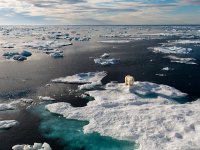Climate Change and Game-Based Learning
To learn about complex systems, students explored the basics of game development for a perspective on the causes and effects of global climate change.
Teaching about complex interconnected systems like global climate change can be difficult. There are many unseen pieces affecting the greater whole that young people (and many adults) might not understand. One approach to lifting this conceptual curtain for students is assigning the BrainPOP video on the topic prior to class, flipping the instruction. Try BrainPOP's Make-a-Map tool, which is an open-ended concept map, a playful assessment, to have students demonstrate interconnections.
Making Climate Change Games
At a recent conference, I learned about EcoChains: Arctic Crisis. This multiplayer card game was produced by the Games Research Lab at Columbia University's Teachers College, and was part of a National Science Foundation grant on climate change education. To play, you build food webs using cards adorned with different animals, which sit upon sea ice cards. Larger animals require more ice to survive upon, which illustrates through play how climate change affects polar regions more immediately than temperate zones. The game has "event cards," which can melt or remove a player's ice cards. Pull a coal card and your polar bear might lose its habitat entirely. There are also green energy event cards (e.g., solar, wind) that return ice level cards to a player's deck. Playing the game will engage your students in experiential learning about the causes and effects of global climate change. Check out lesson ideas, quickstart guides, and videos at EcoChains: Arctic Crisis.
When students make their own climate-themed games, they will gain a deeper understanding of the topic. I recommend the game jam model, in which participants work in teams to design a game based on a theme -- in this case, global climate change. A game jam is essentially a game about making a game, and it's perfect for a PBL science classroom. Students can work in teams researching subtopics, like water pollution or sea levels, and then select a design tool to use, like Scratch, Gamestar Mechanic, or graph paper and dice for a non-digital game.
This spring I took part in Climate Game Jam: Water, organized by NOAA. It was a follow-up event to October 2015's Climate Game Jam. The water topic was announced in a March 2016 White House Fact Sheet on building a sustainable water future. The themes specific to this jam included:
- Changing precipitation patterns
- Freshwater supply and sources
- Ocean acidification
- Polar issues
- Human use of water
- Marine/freshwater ecosystems
There were also different game categories:
- Hack this game (remix from a template)
- Paper prototype
- Analog game
- Basic digital game
- Advanced digital game
Game Jamming to Learn About Complex Systems
The event, coordinated by Peg Steffen, who manages the NOAA Games website, offered an opportunity for student participants to work together on climate game prototypes with facilitators and educators. It was hosted at several places around the country, as well as one in the island of Palau! I helped out at one of the New York City sites: BrainPOP's headquarters. Here, participants first deconstructed the components of the classic pencil-and-paper game Tic-Tac-Toe. Then, in small groups, they "hacked" it by changing the rules of the game's system. Some added extra boxes, while others used dice to add in elements of chance. Finally, groups shared out their creations. At this point, groups chose one of two different rooms, each featuring a different authoring tool.
One room used a Scratch template. Mouse.org's Alex Fleming created it and ran the station. (Mouse.org is a nonprofit that brings STEM opportunities to students in New York City). I was in charge of the Twine station. Twine is a free tool to write choice-based stories. Here, participants had a few more options: create an original story (which many did), or use the story prompts created by BrainPOP's Kevin Miklasz, or the one written by my seventh-grade students about the plight of a whale in polluted waters.
At the conclusion of the afternoon, everyone reconvened to share out games. The Scratch games added to the template, hacking it to be about climate change and water. One group's game changed the goal to be about saving fish, polar bears, and birds. In the Twine station, two groups authored original, branched stories. One was about keeping a lake free from pollutants, while the other included silly meme images in addition to the text. Make the wrong choice about not turning off that faucet and you might see Grumpy Cat telling you that you chose the "wrong answer!" Many of the completed prototyped games were recorded using an iPad camera for submitting them to the jam's national website, as well as the students' digital portfolios. Aside from learning about climate change, water, and game design on a Saturday afternoon, everyone had fun!
Consider having your students play and make games in your science classroom next year. Climate Game Jam offers many resources on climate change. Students can freely remix the Scratch template that we used. And the assets of the two Twine starters, as well as an easy-to-follow, how-to guide, are in this Dropbox folder.
What are some playful and innovative ways that you're using to teach complex systems, like climate change? Please share in the comments below!
